Zuni Pueblo Polychrome Standing Male Figurine - C3868F
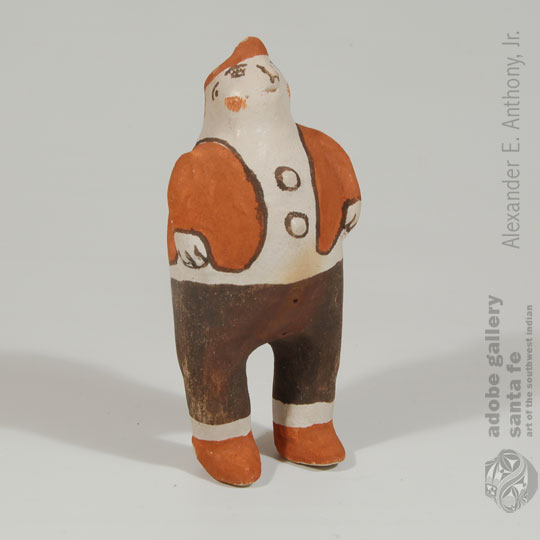 Tourists have always been fascinated with pueblo pottery, but the large, traditional bowls and jars that were in use in the pueblos in the late 19th century were too cumbersome for travel, so the pueblo potters began making small souvenir pieces. Cochiti Pueblo was by far the most prolific in making figurative pottery for the tourists, but Zuni did make some, although not nearly the quantity or the variety. Mostly, Zuni potters made owl figurines.
Tourists have always been fascinated with pueblo pottery, but the large, traditional bowls and jars that were in use in the pueblos in the late 19th century were too cumbersome for travel, so the pueblo potters began making small souvenir pieces. Cochiti Pueblo was by far the most prolific in making figurative pottery for the tourists, but Zuni did make some, although not nearly the quantity or the variety. Mostly, Zuni potters made owl figurines.
This figurine is a fat male, presumably a Zuni Pueblo man. He wears an open vest, has two buttons on his shirt, wears traditional moccasins and has his hair tied in a chonga in the back of his head and wears a head band. He appears to be circa 1940s. He stands unaided but is a little shaky in doing so. The Zuni Pueblo Polychrome Standing Male Figurine is not signed by the maker.
Original Painting of a Ceremonial Drummer by Tonita Vigil Peña - C3868K
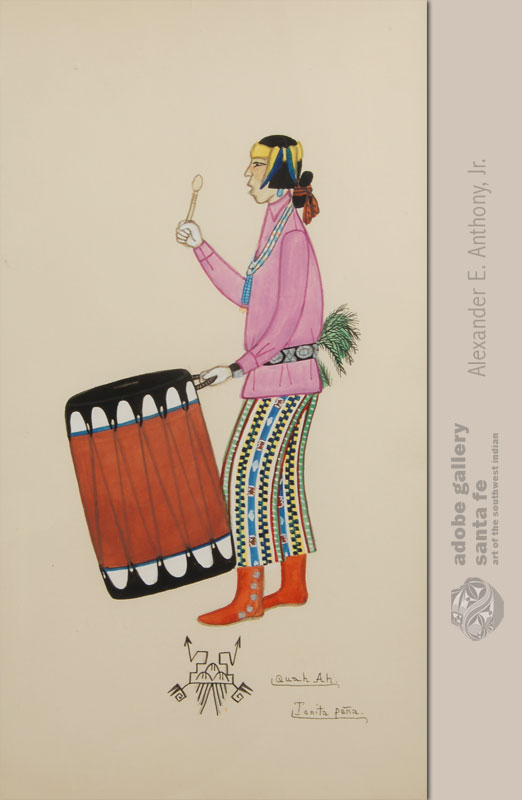 Tonita Peña began painting when she was seven years old. She was the only woman painter in her generation and was part of the original group who participated in the contemporary watercolor movement.
Tonita Peña began painting when she was seven years old. She was the only woman painter in her generation and was part of the original group who participated in the contemporary watercolor movement.
In this Original Painting of a Ceremonial Drummer, Tonita presents a drummer during a San Ildefonso Pueblo ceremony. He is shown with his mouth open indicating he is chanting while drumming. The early pueblo style of painting, which has no ground plane and no background, was meticulously carried out in this piece.
Navajo Silver and Turquoise Squash Blossom Necklace with Tufa Cast Naja - C3864.47
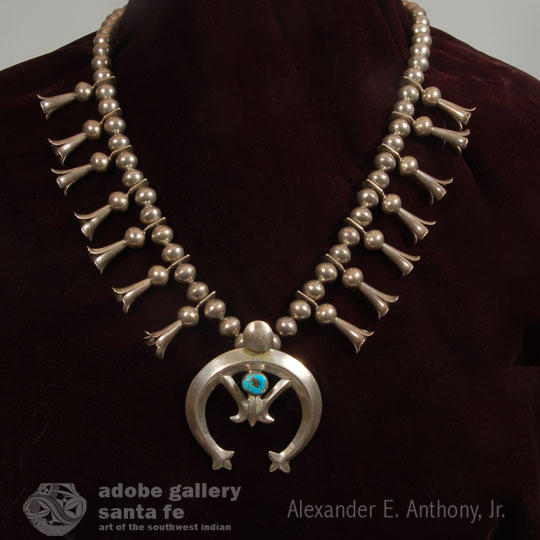 The Navajo incorporated the naja in their jewelry as a pendant dangling on silver necklaces, commonly called squash blossom necklaces. In this instance, a beautiful cast silver naja with a pair of blossoms curving around a fleur de lis and capped with a beautiful blue turquoise cab is suspended from a string of handmade silver beads. The naja was formed by tufa casting, then the turquoise cab was added.
The Navajo incorporated the naja in their jewelry as a pendant dangling on silver necklaces, commonly called squash blossom necklaces. In this instance, a beautiful cast silver naja with a pair of blossoms curving around a fleur de lis and capped with a beautiful blue turquoise cab is suspended from a string of handmade silver beads. The naja was formed by tufa casting, then the turquoise cab was added.
There are 14 silver blossoms and 60 silver beads that were formed as hemispheres and then soldered together to form spheres (see below for detail image). The necklace has silver cones at each end and each of the cones has a saguaro cactus stamped into the silver (see above for detail image). This could be the hallmark of the maker or could be just a decorative touch.
Turn of the Century Western Apache Basket Olla - C3869
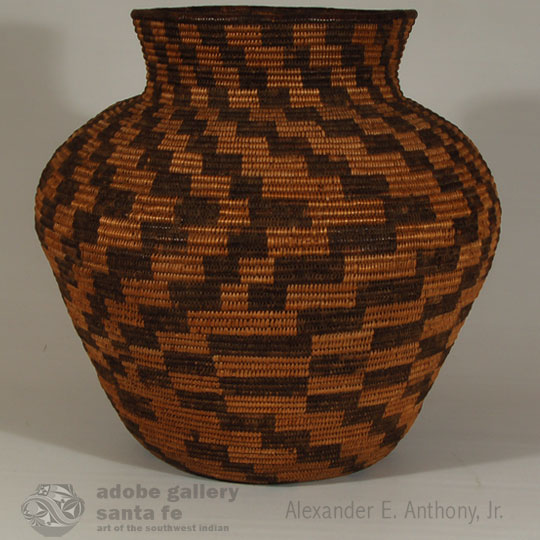 The members of the Yavapai-Apache Nation, a sovereign Native American tribe from the Verde Valley, Arizona, have two culturally distinct backgrounds and speak two indigenous languages. The Yavapai originate from Yuman-speaking peoples known as the Pai and the Apache descend from an Athapaskan background like other Apache groups to the East.
The members of the Yavapai-Apache Nation, a sovereign Native American tribe from the Verde Valley, Arizona, have two culturally distinct backgrounds and speak two indigenous languages. The Yavapai originate from Yuman-speaking peoples known as the Pai and the Apache descend from an Athapaskan background like other Apache groups to the East.
Originally, the Yavapai and Apache tribes were separate and distinct tribes who coexisted peacefully for several hundred years. They have existed as one tribal nation since 1934. The Yavapai-Apache Tribal Reservation is located at Camp Verde, about 90 miles north of Phoenix and 50 miles south of Flagstaff, along Interstate 17. They are generally referred to as Western Apache.
San Ildefonso Pueblo Black Carved Jar by Rose Gonzales - C3868i
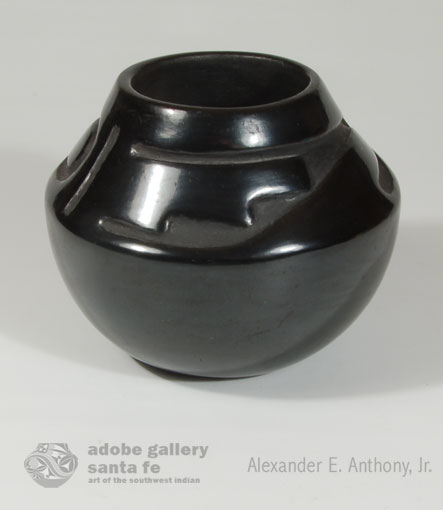 This jar was originally purchased from the Popovi Da Studio at San Ildefonso Pueblo. The Popovi Da Studio was originally opened to display and sell pottery by Maria Martinez and family members. Popovi eventually added pottery and paintings by other local artists to his inventory. After Popovi died in 1972, his widow Anita Da continued operating the studio for several years and finally closed it sometime in the late 1990s or early 2000s. Popovi's personal collection of Martinez family pottery that was displayed at the Studio was then sold to the Millicent Rogers Museum in Taos.
This jar was originally purchased from the Popovi Da Studio at San Ildefonso Pueblo. The Popovi Da Studio was originally opened to display and sell pottery by Maria Martinez and family members. Popovi eventually added pottery and paintings by other local artists to his inventory. After Popovi died in 1972, his widow Anita Da continued operating the studio for several years and finally closed it sometime in the late 1990s or early 2000s. Popovi's personal collection of Martinez family pottery that was displayed at the Studio was then sold to the Millicent Rogers Museum in Taos.
Rose Gonzales was one of the potters featured at Popovi's Studio. She was originally from Ohkay Owingeh (San Juan) Pueblo. After she married Robert Gonzales of San Ildefonso Pueblo she moved there with him. Rose was a sister of Pomasena Sanchez. She was the mother of Jose H. Rainbird Gonzales, Tse-Pé Gonzales, and Marie Gonzales Yazzie. Rose learned pottery making from Ramona Sanchez Gonzales, her mother-in-law. Rose's parents died from the swine flu epidemic of 1918, leaving Rose and her sister Pomasena orphaned. The girls survived by staying at the Santa Fe Indian School. Mary Cata, a relative, adopted and cared for the girls. Rose lived at San Ildefosno for the remainder of her life.
Matte and Polished Red Pottery Basketry Bowl by Sue Tapia - C3868D
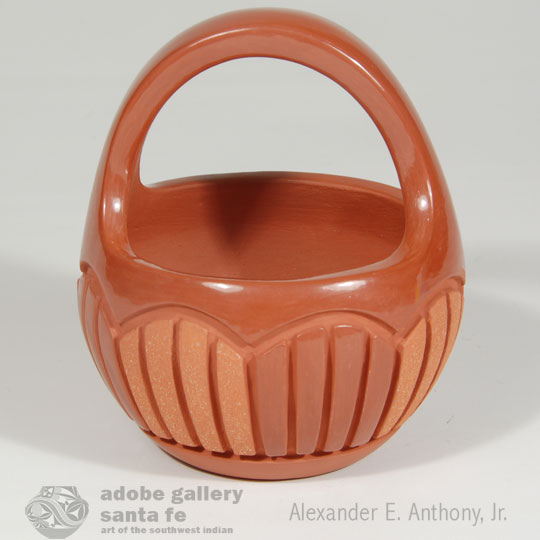 Sue Poncho Tapia is a potter originally from Laguna Pueblo, who married Tom Tapia from Ohkay Owingeh Pueblo. She and her husband make Ohkay Owingeh style pottery. This small bowl with a handle was beautifully carved with vertical ribs. Each group of four vertical ribs alternates with polished red finish and micaceous finish. The arched handle and area of the rim are finished in a polished state. The underside of the bowl is matte finish.
Sue Poncho Tapia is a potter originally from Laguna Pueblo, who married Tom Tapia from Ohkay Owingeh Pueblo. She and her husband make Ohkay Owingeh style pottery. This small bowl with a handle was beautifully carved with vertical ribs. Each group of four vertical ribs alternates with polished red finish and micaceous finish. The arched handle and area of the rim are finished in a polished state. The underside of the bowl is matte finish.
Santa Clara Pueblo Small Red Melon Jar by Angela Baca - C3868E
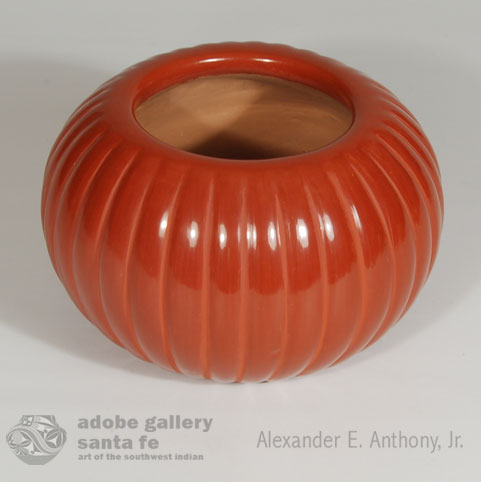 Contemporary melon jars had their start at Santa Clara Pueblo sometime in the 1960s. It is not known who was the first to make them but we know that Severa Tafoya (1890-1973), mother of Angela Baca, made them. Angela Baca (1927-2014) also made them and was probably the best known at the time for both black and red melon jars. Later, Helen Shupla (1928-1985) made them. Many other potters are now making versions of melon jars.
Contemporary melon jars had their start at Santa Clara Pueblo sometime in the 1960s. It is not known who was the first to make them but we know that Severa Tafoya (1890-1973), mother of Angela Baca, made them. Angela Baca (1927-2014) also made them and was probably the best known at the time for both black and red melon jars. Later, Helen Shupla (1928-1985) made them. Many other potters are now making versions of melon jars.
Angela Baca is still probably the best known for melon jars of the original style. Helen Shupla's melon jars were of a different style. This small red melon jar is very traditionally an Angela Baca one. The ribs are stone polished and the lines between ribs are in matte finish. The melon ribs extend from the rim to the base. The jar is signed Angela Baca on the underside.
Hopi Small Bowl with Rim Design by Dextra Quotskuyva Nampeyo - C3868C
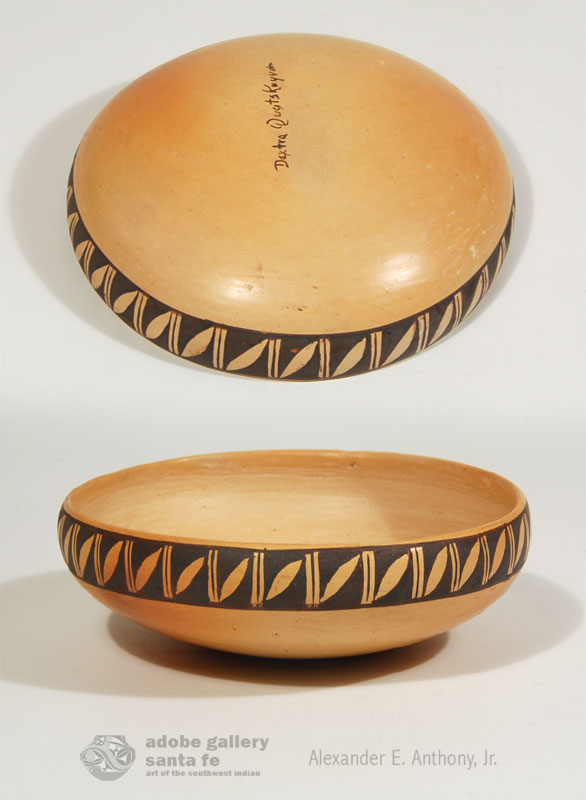 This Hopi Small Bowl with Rim Design was constructed with native clay and stone polished on the interior and exterior without addition of slip. The burnish is on the natural clay body. The design was painted on the exterior of the rim in a repetitive pattern in dark brown pigment.
This Hopi Small Bowl with Rim Design was constructed with native clay and stone polished on the interior and exterior without addition of slip. The burnish is on the natural clay body. The design was painted on the exterior of the rim in a repetitive pattern in dark brown pigment.
The bowl is simple and elegant and a testament to the creative talent of Dextra Quotskuyva Nampeyo (1928- ) who could visualize the elegance of a simple design on an open bowl and apply the design with painted perfection. It is signed Dextra Quotskuyva on the underside.
Navajo Silver and Turquoise Floral Design Ring - C3864.36
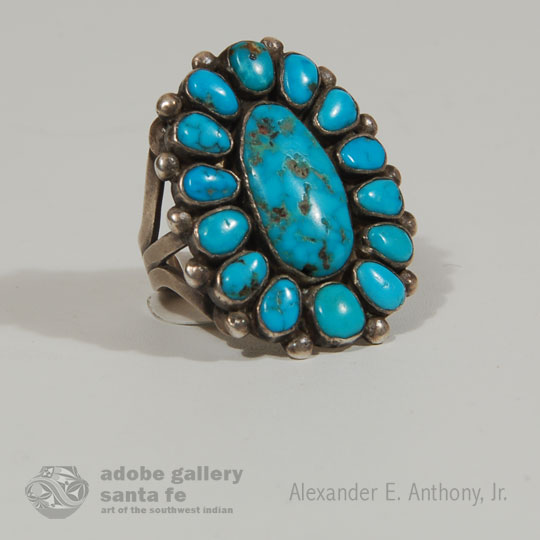 The turquoise in this ring is all natural with very little matrix. The individual cabs are beautiful sky blue in color and have imperfections that are natural. The Navajo Silver and Turquoise Floral Design Ring has a charming appeal as if made by and for its Navajo creator.
The turquoise in this ring is all natural with very little matrix. The individual cabs are beautiful sky blue in color and have imperfections that are natural. The Navajo Silver and Turquoise Floral Design Ring has a charming appeal as if made by and for its Navajo creator.
The silver shank branches out at the base of the ring into three sections. At the end of each of the branches is a silver dot, a little extra touch not normally applied by most artisans.
Untitled Painting Hair Washing with Yucca Root Shampoo by Gerald Nailor - 25934
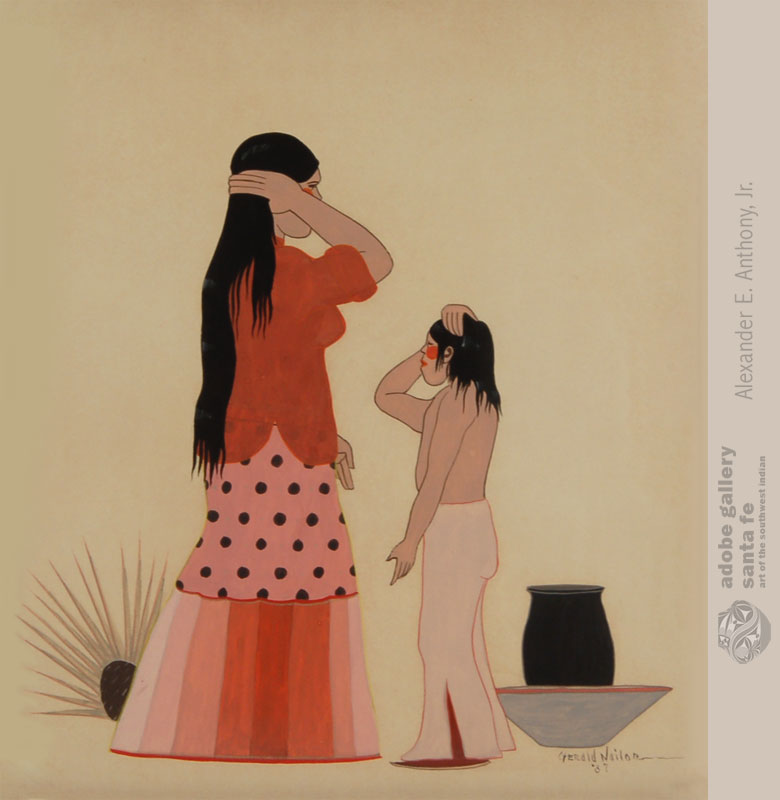 Gerald Nailor (1917-1952) painted in a decorative manner unlike any other Navajo artist. His style was unique and quite recognizable. He generally painted in soft matte colors.
Gerald Nailor (1917-1952) painted in a decorative manner unlike any other Navajo artist. His style was unique and quite recognizable. He generally painted in soft matte colors.
Other than these images, there are no other sky or background images to distract from the main subject matter. The Untitled Painting Hair Washing with Yucca Root Shampoo is signed Gerald Nailor '37 in lower right.
Original Woodcut Tosca by T. C. Cannon Pai-doung-u-day - 25924
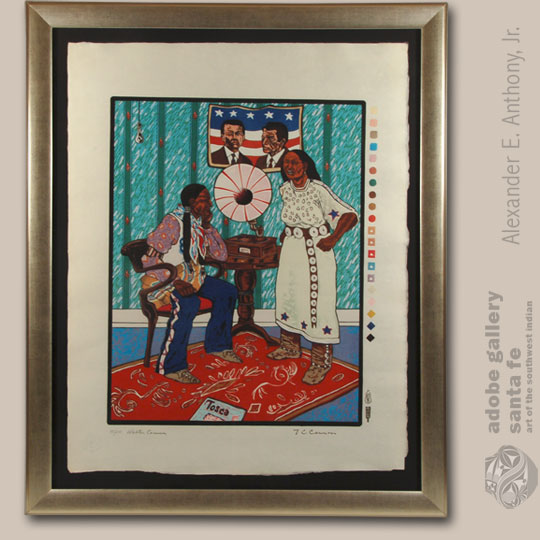 T. C. Cannon (1946-1978) Pai-doung-u-day "One Who Stands In The Sun" died young and left behind a beautiful, powerful oeuvre. He was born in 1946 in Lawton, Oklahoma, and died in an automobile accident in Santa Fe in 1978.
T. C. Cannon (1946-1978) Pai-doung-u-day "One Who Stands In The Sun" died young and left behind a beautiful, powerful oeuvre. He was born in 1946 in Lawton, Oklahoma, and died in an automobile accident in Santa Fe in 1978.
He had attended the Institute of American Indian Arts in Santa Fe, studying with Fritz Scholder. He seemed somewhat bitter and distrustful of authority. One of his teachers suggested to T. C. that they get in two rocking chairs facing each other and rock and frown until all the aggression was gone. He was away from home for the first time, so perhaps his quiet and reflective nature was misread as bitterness.
In 1975, T. C. Cannon began a collaboration with Japanese master woodcutter Maeda and master printer Uchikawa, a collaboration that continued until Cannon's untimely death in 1978. The result was the publication of the Memorial Woodcut Suite. In 1978, Cannon traveled to New York to sign the first two of the completed Japanese woodcuts. He returned to Santa Fe and died in an automobile accident on May 8th. Cannon's father, Walter, signed the remaining woodcut prints for his son.
Polacca Polychrome Inspired Contemporary Hopi Bowl by Mark Tahbo - 25930
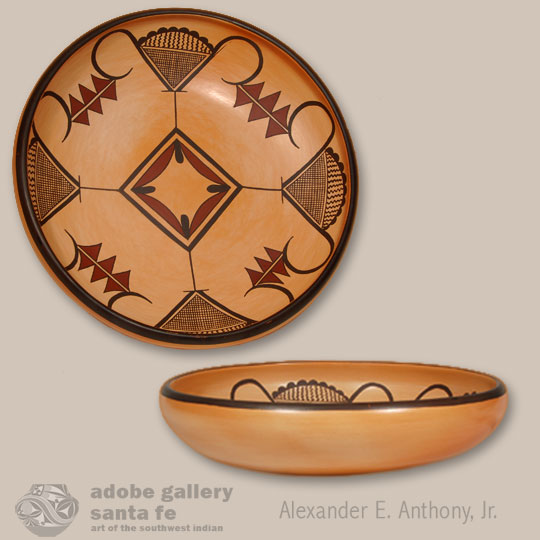 Today, Hopi Pueblo potter Mark Tahbo is mimicking those potters of more than a hundred years ago, who were mimicking those of almost a thousand years before their time. Just like the potters of the 1890s were reintroducing designs from the Sikyatki potters, Mark Tahbo is reintroducing designs from the potters of the 1890s. He is using designs from Polacca Polychrome pottery as his inspiration for some of his pottery today.
Today, Hopi Pueblo potter Mark Tahbo is mimicking those potters of more than a hundred years ago, who were mimicking those of almost a thousand years before their time. Just like the potters of the 1890s were reintroducing designs from the Sikyatki potters, Mark Tahbo is reintroducing designs from the potters of the 1890s. He is using designs from Polacca Polychrome pottery as his inspiration for some of his pottery today.
Hopi Pueblo Seated Koshare Clown with Watermelon by Fletcher Healing - C3868A
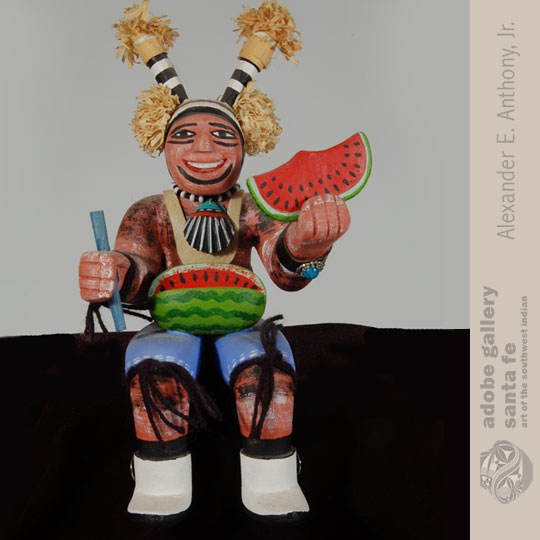 Fletcher Healing was the grandson of Annie Healing Nampeyo and great-grandson of Nampeyo of Hano. Unlike the rest of the Hopi Pueblo family members, he was not a potter but chose to carve Katsina dolls. He was known for making these seated clowns whose legs hang over from the shelf.
Fletcher Healing was the grandson of Annie Healing Nampeyo and great-grandson of Nampeyo of Hano. Unlike the rest of the Hopi Pueblo family members, he was not a potter but chose to carve Katsina dolls. He was known for making these seated clowns whose legs hang over from the shelf.
Kewa (Santo Domingo) Pueblo Three-strand Shell Hieshe Necklace - C3864.46
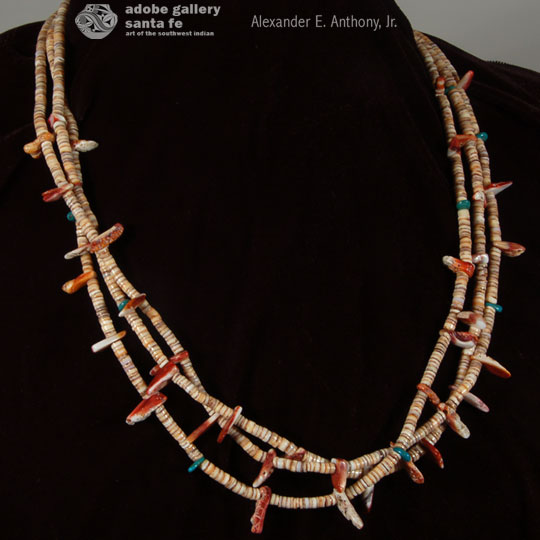 Kewa (formerly Santo Domingo) Pueblo artisans have been known for decades for the fine hieshe necklaces they produce. It is a style they have made for their own use for a thousand or more years, long before they started into silverwork. Hieshe is made from sea shells. The shells are first cut into small square sections, drilled in the center, strung on wire or string, then sanded by hand, in an up and down stroke, until each one is round. That sounds easy but is not. It is important to exert the same pressure on every stroke to achieve hieshe of the same diameter when finished.
Kewa (formerly Santo Domingo) Pueblo artisans have been known for decades for the fine hieshe necklaces they produce. It is a style they have made for their own use for a thousand or more years, long before they started into silverwork. Hieshe is made from sea shells. The shells are first cut into small square sections, drilled in the center, strung on wire or string, then sanded by hand, in an up and down stroke, until each one is round. That sounds easy but is not. It is important to exert the same pressure on every stroke to achieve hieshe of the same diameter when finished.
Hopi Polychrome Open Bowl with Interior Design by Nampeyo of Hano - C3863D
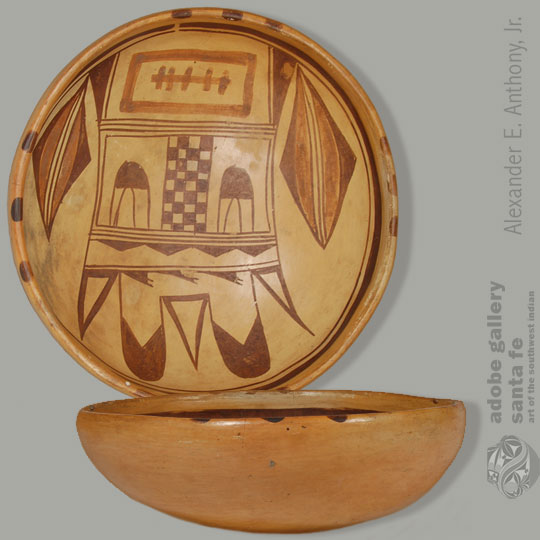 This exquisite small bowl is attributed to Nampeyo of Hano based on construction techniques, layout of design, and execution of design. One of the first items of consideration is the extra coil of clay Nampeyo placed at the interior rim of bowls, which is easily determined by rubbing one's hand along the rim interior. Such a coil is evident in this bowl. The bottom is rounded, not flattened, and shows evidence of long polishing strokes as was typical of Nampeyo. The layout of the design is very typical of her style.
This exquisite small bowl is attributed to Nampeyo of Hano based on construction techniques, layout of design, and execution of design. One of the first items of consideration is the extra coil of clay Nampeyo placed at the interior rim of bowls, which is easily determined by rubbing one's hand along the rim interior. Such a coil is evident in this bowl. The bottom is rounded, not flattened, and shows evidence of long polishing strokes as was typical of Nampeyo. The layout of the design is very typical of her style.
Fred Harvey Style Bracelet with Silver Bars and Silver Button - C3864.16
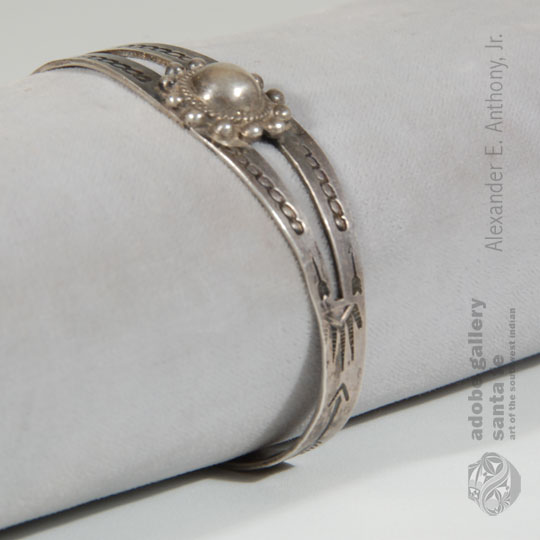 This Fred Harvey Style Bracelet with Silver Bars and Silver Button has a hand-formed silver button surrounded by smaller silver balls to create a characteristic Fred Harvey style bracelet. Arrow and cloud motifs adorn the sides and the split shank gives the bracelet a delicate, airy feel.
This Fred Harvey Style Bracelet with Silver Bars and Silver Button has a hand-formed silver button surrounded by smaller silver balls to create a characteristic Fred Harvey style bracelet. Arrow and cloud motifs adorn the sides and the split shank gives the bracelet a delicate, airy feel.
Fred Harvey Style Navajo Bracelet with One Stone - C3864.01
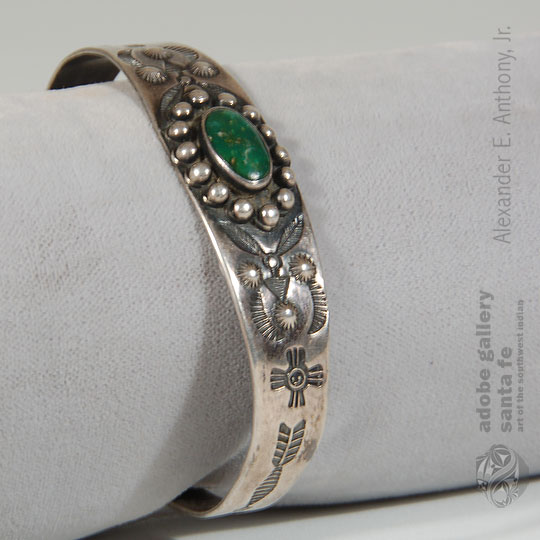 This Fred Harvey Style Navajo Bracelet with One Stone features diamonds, arrows, Zia Sun and crescent shaped stamps which are so characteristic to the Fred Harvey style. The stamps symmetrically surround a beautiful deep green turquoise stone, which is surrounded by silver dots.
This Fred Harvey Style Navajo Bracelet with One Stone features diamonds, arrows, Zia Sun and crescent shaped stamps which are so characteristic to the Fred Harvey style. The stamps symmetrically surround a beautiful deep green turquoise stone, which is surrounded by silver dots.
Fred Harvey Style Navajo Bracelet with Single Stone and Stamping - C3864.12
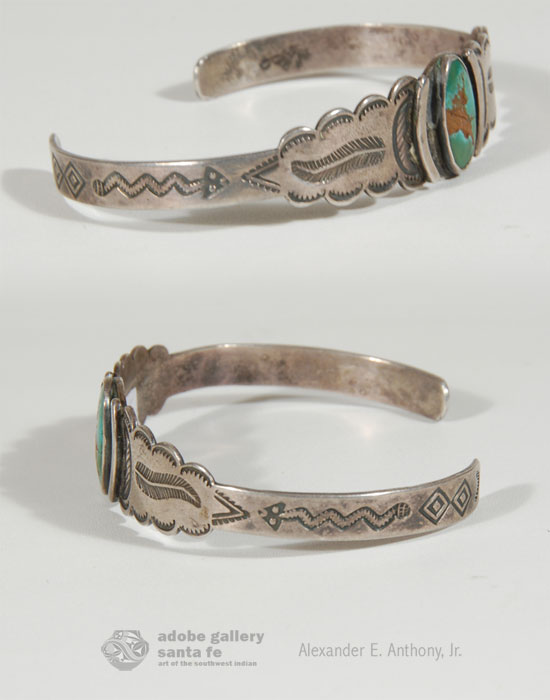 When Fred Harvey hired anthropologists to help him create and market designs for the travelers, one of the things the company determined was that the style needed to attract buyers. This lovely Fred Harvey Style Navajo Bracelet with Single Stone and Stamping features typical southwestern designs, feather and animal stamps and turquoise, but it also has the graceful scalloped edges and delicate feel that was intended to attract the attention of the tourist.
When Fred Harvey hired anthropologists to help him create and market designs for the travelers, one of the things the company determined was that the style needed to attract buyers. This lovely Fred Harvey Style Navajo Bracelet with Single Stone and Stamping features typical southwestern designs, feather and animal stamps and turquoise, but it also has the graceful scalloped edges and delicate feel that was intended to attract the attention of the tourist.
Fred Harvey Style Thin Silver Band with Repoussé - C3864.24
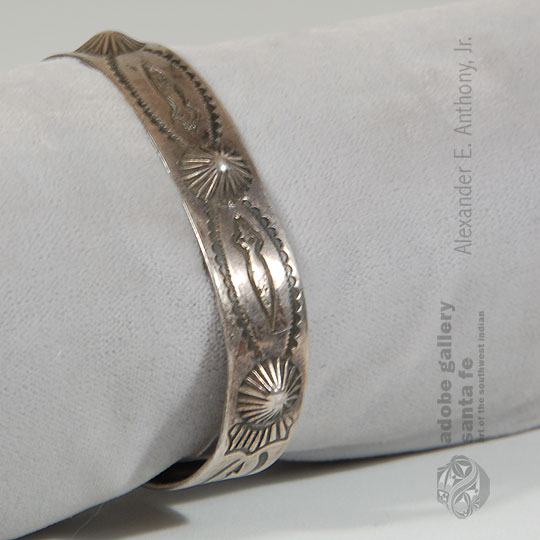 Jewelry made by Native American artists, working for the Fred Harvey Company, to be sold to travelers at the Fred Harvey hotels, was different from the jewelry they made for themselves. The esthetic was geared more towards what was more attractive for the tourists. Thus, a unique style was created, and marketed and has endured to this day. The style consists of stamp motifs with arrows, diamonds, animals and distinct geometric designs, that today we identify as the "Fred Harvey Style."
Jewelry made by Native American artists, working for the Fred Harvey Company, to be sold to travelers at the Fred Harvey hotels, was different from the jewelry they made for themselves. The esthetic was geared more towards what was more attractive for the tourists. Thus, a unique style was created, and marketed and has endured to this day. The style consists of stamp motifs with arrows, diamonds, animals and distinct geometric designs, that today we identify as the "Fred Harvey Style."
Navajo Silver and Turquoise Bracelet with Button and Repoussé - C3864.10
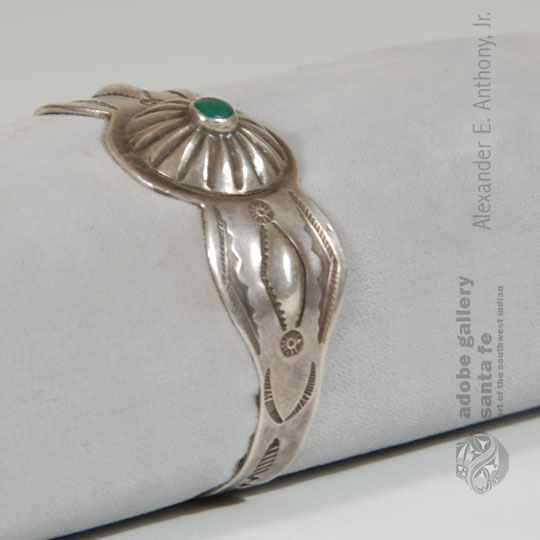 The unknown artist who created this Silver and Turquoise Bracelet with Button and Repoussé innovatively added a button to where a stone usually would be placed. Perhaps he wanted to repurpose a single button, or perhaps he had no more larger stones. Whatever the reason, this button bracelet is unique. The sides feature all the characteristics of Fred Harvey style jewelry; geometric stamping in addition to repoussé diamonds. It is the button which makes it exceptional. I like to think it is an early example of Native American repurposing.
The unknown artist who created this Silver and Turquoise Bracelet with Button and Repoussé innovatively added a button to where a stone usually would be placed. Perhaps he wanted to repurpose a single button, or perhaps he had no more larger stones. Whatever the reason, this button bracelet is unique. The sides feature all the characteristics of Fred Harvey style jewelry; geometric stamping in addition to repoussé diamonds. It is the button which makes it exceptional. I like to think it is an early example of Native American repurposing.
The Fred Harvey Company had anthropologists on its staff to consult with Native American artists to design quality souvenirs and provide tourists with an "Authentic Southwest Experience." Perhaps this artisan expressed his individuality in the creation of this bracelet.

